Visually Impaired People Face Difficulties Throughout Pandemic
By Jillian Price and Mizelle Mayo
Reporting Texas

Walgreens pharmacist Sherri Nematzadeh administers a COVID-19 vaccine during a special clinic for visually impaired people at Austin Lighthouse for the Blind on April 30, 2021. James Boswell/Reporting Texas
As Marcey Gonzalez, who is visually impaired, was navigating websites in March to schedule a COVID-19 vaccine, she grew increasingly frustrated.
Gonzalez can see, she said, “but I cannot do it quickly, and before I could finish [registering on the website] it would time out,” Gonzalez said.
Gonzalez’s visually impaired friends have also struggled to schedule vaccines and have faced other COVID-19-related challenges that might not occur to sighted people, Gonzalez added.
About 700,000 people in Texas are visually impaired, according to the most recent numbers from the National Federation of the Blind. In a series of interviews with Reporting Texas, visually impaired Austinites and their advocates in Central Texas discussed the difficulty of getting vaccinated for COVID-19 and the challenge of avoiding the illness during the pandemic.
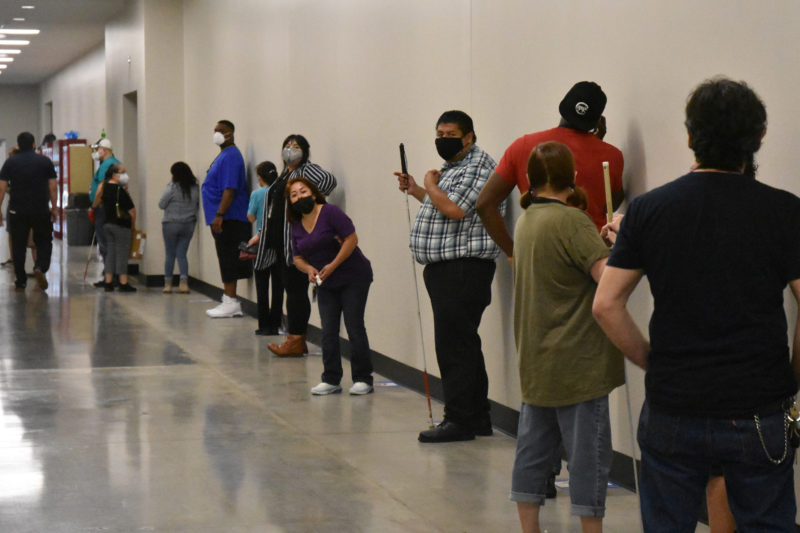
Austin Lighthouse for the Blind employees wait for vaccinations during a special clinic hosted on-site on April 30, 2021. James Boswell/Reporting Texas
19 and the challenge of avoiding the illness during the pandemic.
Jim Meehan, president and CEO of Austin Lighthouse for the Blind, has worked with visually impaired people for 23 years. Austin Lighthouse for the Blind is a nonprofit organization that trains and employs 450 people, at least half of whom are blind. Employees pack and distribute uniforms for the military, and during the pandemic, they packed and shipped hand sanitizer.
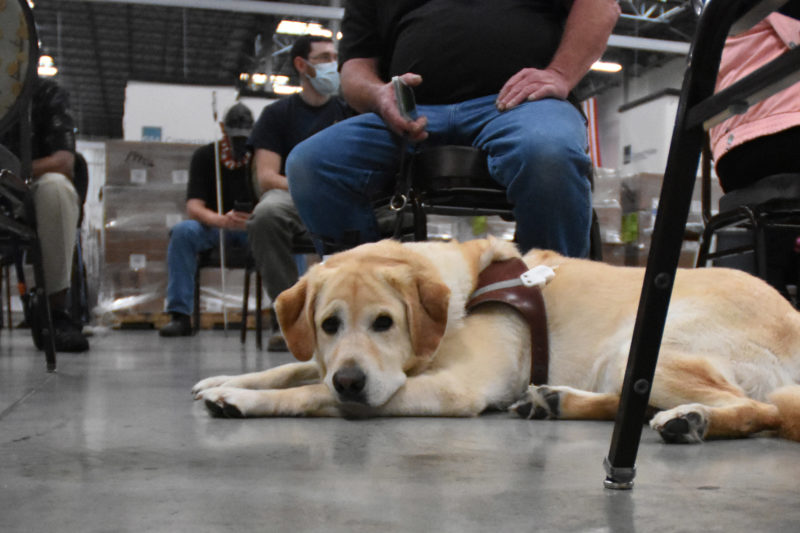
Verde, a guide dog, waits while his owner sits in the observation area after receiving a COVID-19 vaccine at Austin Lighthouse for the Blind on April 30, 2021. James Boswell/Reporting Texas
There are more than 20,000 people in Metro Austin with a visual difficulty, Meehan said.
“Blind people are tactile. They touch a lot. They touch the handrails, they touch the walls, they touch surfaces, because that helps them navigate,” Meehan said. “If [the virus] is on the surface, they will be more susceptible, and so that was a fear.”
Meehan’s organization has provided hand-washing stations, hand sanitizer and masks to protect employees during the pandemic. It also has fogged buildings with an antiviral disinfectant. Fogging was essential to keep buildings clean because it disinfected surfaces that were not accessible or easy to clean, Meehan said.
At least 30 employees at Austin Lighthouse have gotten COVID-19, Meehan added.
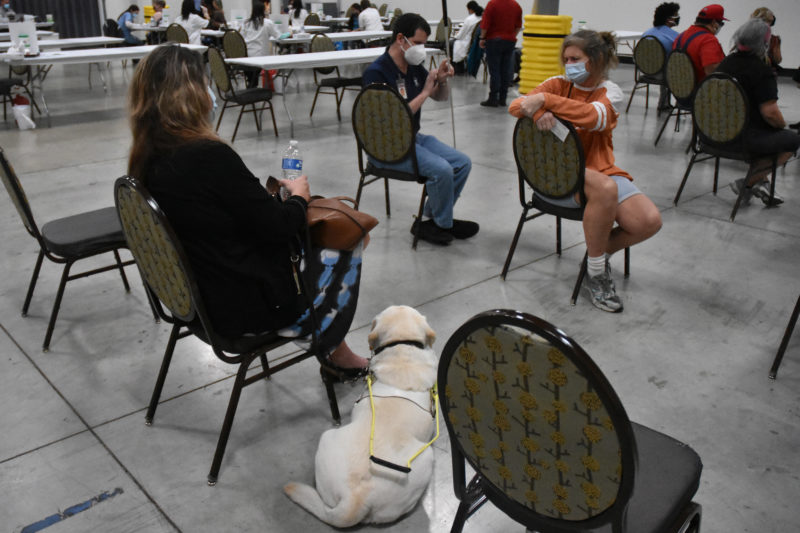
A special vaccine clinic for visually impaired people makes it easy for them to socially distance while they wait in the observation area at Austin Lighthouse for the Blind on April 30, 2021. James Boswell/Reporting Texas
Oumar Diallo, 29, is an employee of Austin Lighthouse who works on the custodial team. Diallo, who is visually impaired, said maintaining social distancing can be more difficult for those who don’t see well. Diallo works in close proximity to dozens of other employees at Austin Lighthouse’s main location.
“In the beginning, it was hard to stay distanced from people even if you want to,” Diallo said.
“Even at work, it’s impossible to stay six feet away. Just got to protect yourself as much as you can.” Diane Perez, 46, works as a trainer and interpreter for Austin Lighthouse. One pandemic challenge has been maintaining cleanliness, Perez said. Supervisors had difficulty keeping track of employees in the facility, so it was up to employees to hold themselves accountable and maintain cleanliness, she said.
“That’s a concern that I think most of us have, you know, how clean were the people being, and are other people really using this hand sanitizer,” she added.
Many visually impaired people use MetroAccess, the taxpayer funded ride service for people with disabilities, to get around town, Perez said. Long waiting periods for MetroAccess rides are not new, but the pandemic has made the situation more fraught, she added.
If a rider schedules a pickup between 3:30 and 4 p.m., rather than a specific pickup time, riders often have to wait for half an hour, she said, and waiting with strangers for a ride has raised concerns about potential exposure to COVID-19. The cleanliness of the MetroAccess buses has also been a concern, Perez said.
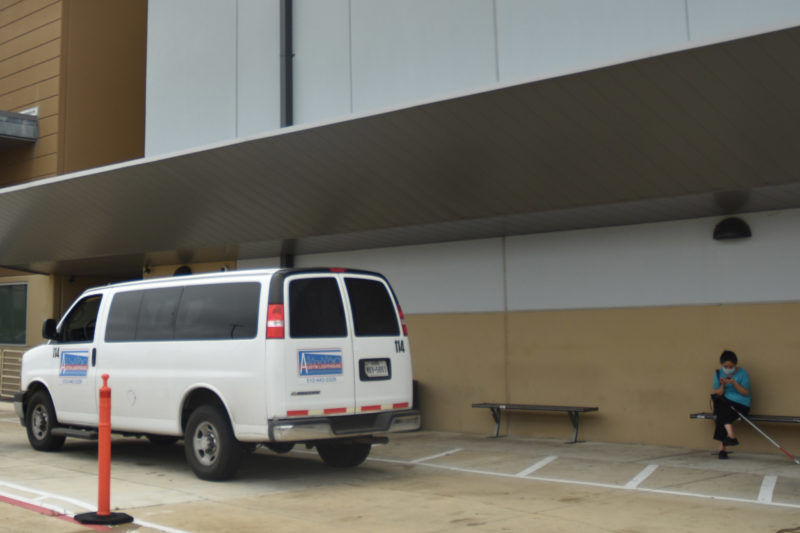
A shuttle waits to transport patients from a vaccine clinic hosted by Austin Lighthouse for the Blind on April 30, 2021. The shuttle provided an alternative transport for riders tired of MetroAccess’ long wait times. James Boswell/Reporting Texas
You just don’t know how clean the vehicles are, Perez said. “We get on there and we ride, that’s it,” she added.
Capital Metro has been taking extra steps to make sure their customers are safe and comfortable. Steps include contactless payments, hand sanitizing stations and an upgrade from fabric to vinyl seats, making it easier to clean.
Meehan of the Austin Lighthouse said people most often don’t realize how hard the pandemic has been on the blind and visually impaired, but he is grateful for those who have reached out to help the community.
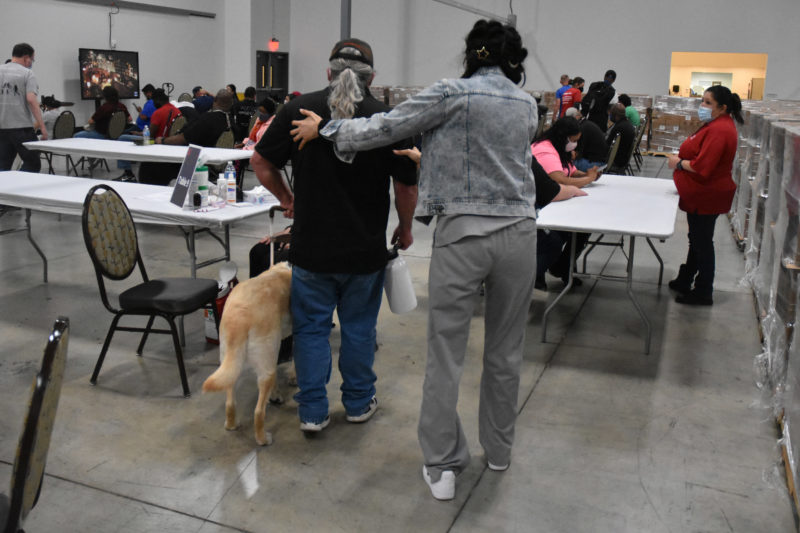
Visually impaired persons receive a more personal approach when getting vaccinated during a special clinic hosted by Austin Lighthouse for the Blind on April 30, 2021. About 300 people attended the event which didn’t require pre-registration which can be challenging for those who can’t see a computer screen. James Boswell/Reporting Texas
In April, Walgreens partnered with the Austin Lighthouse to vaccinate 300 blind and visually impaired people in Austin. People could show up without registering to get vaccinated.
Considering the difficulties visually impaired people have faced trying to schedule vaccinations, the event “was just like manna from heaven,” Meehan said.